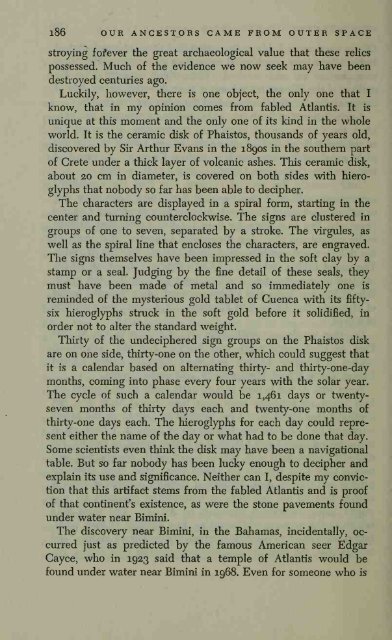You also want an ePaper? Increase the reach of your titles
YUMPU automatically turns print PDFs into web optimized ePapers that Google loves.
l86<br />
OUR ANCESTORS CAME FROM OUTER SPACE<br />
stroying fofever the great archaeological value that these relics<br />
possessed.<br />
Much of the evidence we now seek may have been<br />
destroyed centuries ago.<br />
Luckily, however, there is one object, the only one that I<br />
know, that in my opinion comes from fabled Atlantis. It is<br />
unique at this moment and the only one of its kind in the whole<br />
world. It is the ceramic disk of Phaistos, thousands of years old,<br />
discovered by Sir Arthur Evans in the 1890s in the southern part<br />
of Crete under a thick layer of volcanic ashes. This ceramic disk,<br />
about 20 cm in diameter, is covered on both sides with hieroglyphs<br />
that nobody so far has been able to decipher.<br />
The characters are displayed in a spiral form, starting in the<br />
center and turning counterclockwise. The signs<br />
are clustered in<br />
groups of one to seven, separated by a stroke. The virgules, as<br />
well as the spiral line that encloses the characters, are engraved.<br />
The signs themselves have been impressed in the soft clay by a<br />
stamp or a seal. Judging by the fine detail of these seals, they<br />
must have been made of metal and so immediately one is<br />
reminded of the mysterious gold tablet of Cuenca with its fiftysix<br />
hieroglyphs struck in the soft gold before it solidified, in<br />
order not to alter the standard weight.<br />
Thirty of the undeciphered sign groups on the Phaistos<br />
disk<br />
are on one side, thirty-one on the other, which could suggest that<br />
it is a calendar based on alternating thirty- and thirty-one-day<br />
months, coming into phase every four years with the solar year.<br />
The cycle of such a calendar would be 1,461 days or twentyseven<br />
months of thirty days each and twenty-one months of<br />
thirty-one days each. The hieroglyphs for each day could represent<br />
either the name of the day or what had to be done that day.<br />
Some scientists even think the disk may have been a navigational<br />
table. But so far nobody has been lucky enough to decipher and<br />
explain its use and significance. Neither can I, despite my conviction<br />
that this artifact stems from the fabled Atlantis and is proof<br />
of that continent's existence, as were the stone pavements found<br />
under water near Bimini.<br />
The discovery near Bimini, in the Bahamas, incidentally, occurred<br />
just as predicted by the famous American seer Edgar<br />
Cayce, who in 1923 said that a temple of Atlantis would be<br />
found under water near Bimini in 1968. Even for someone who is

















